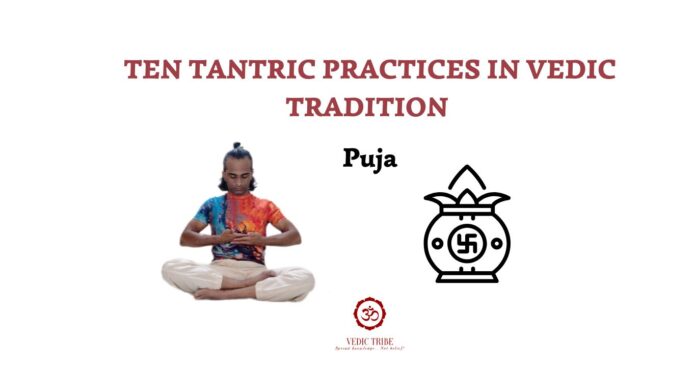Puja: More Than Just worship
In the previous article, we discussed Prayaschitta and in this article we will discuss Puja.
In Sanskrit, “Puja” simply means “worship.” However, unlike some religions that focus on a single God, Vedic traditions celebrate a wide variety of ways to connect with the divine. Even the ancient ritual of “yajna” is considered a form of worship.
Puja: Using Many Tools for Worship
Medium: From a tantric perspective, Puja involves using various mediums or tools to connect with the divine. It’s not just about reciting prayers; it’s about engaging all your senses and using physical objects to create a spiritual experience.
– Multisensory engagement with the divine, where a diverse array of mediums and tools are employed to facilitate a profound connection.
– This approach emphasizes the integration of physical objects, such as images, yantras, and offerings, alongside sensory stimuli like incense, flowers, and chants, to create a holistic spiritual experience.
– By activating all senses, the practitioner immerses themselves in a ritualistic environment that fosters a deeper, more tangible sense of communion with the divine.
– The act of Puja, therefore, becomes a dynamic interplay between the internal state of devotion and the external manifestations of sacred objects and sensory experiences, effectively bridging the gap between the physical and spiritual realms.
Sandhyavandana: In Sandhyavandana, the physical sun and the deity Surya are used as mediums to worship the supreme being. This means that by honoring the physical sun, you are honoring the divine.
Srividya Upasana: This tradition uses a wide range of mediums in its worship, including mandalas (geometric diagrams), chakras (energy centers), yantras (geometric tools), the physical body, and kundalini energy (spiritual energy within the body). This illustrates the diverse tools available for worship.
Buddhism differs in its approach: While the concept of an almighty God is generally rejected, Gautama Buddha and other Buddhas are revered as enlightened beings, guides, and liberators.
Mandalas and chakras are used, but primarily as tools for meditation and elevating the state of mind, not as objects of worship. Worship in Buddhism often involves offering prayers, lighting lamps, and burning incense. These actions are intended to create a peaceful and respectful atmosphere.
Puja for Personal Growth:
Developing Virtues: Puja can be a way to cultivate the qualities of deities within yourself. For example, worshiping a deity associated with compassion can help you develop compassion.
– This process transcends mere ritualistic actions, becoming a form of spiritual modelling.
– By consistently directing one’s attention and devotion towards a deity embodying virtues like compassion, wisdom, or courage, the practitioner gradually absorbs these qualities, mirroring them in their own thoughts, emotions, and actions.
– The act of worship, through mantras, offerings, and visualizations, creates a mental and emotional environment conducive to the manifestation of these desired traits, essentially allowing the deity’s essence to permeate and transform the practitioner’s inner landscape, thus fostering personal growth and spiritual development.
Ishta-Devata: If you’re new to spiritual practice, you can start by worshiping your “ishta-devata,” the deity you feel a personal connection with. This allows for a personal and meaningful connection to the divine.
In Simple Terms:
Puja is about using different tools and methods to connect with the divine. In Vedic traditions, this can involve worshiping many different forms of the divine. In Buddhism, it’s more about honoring enlightened beings and using tools for meditation. Regardless of the tradition, Puja is a way to bring spiritual awareness into your life. It is about creating a connection between the physical and the spiritual.
In the next article, we will discuss “Vrata”
Madhwesh K
Vedic Tribe

